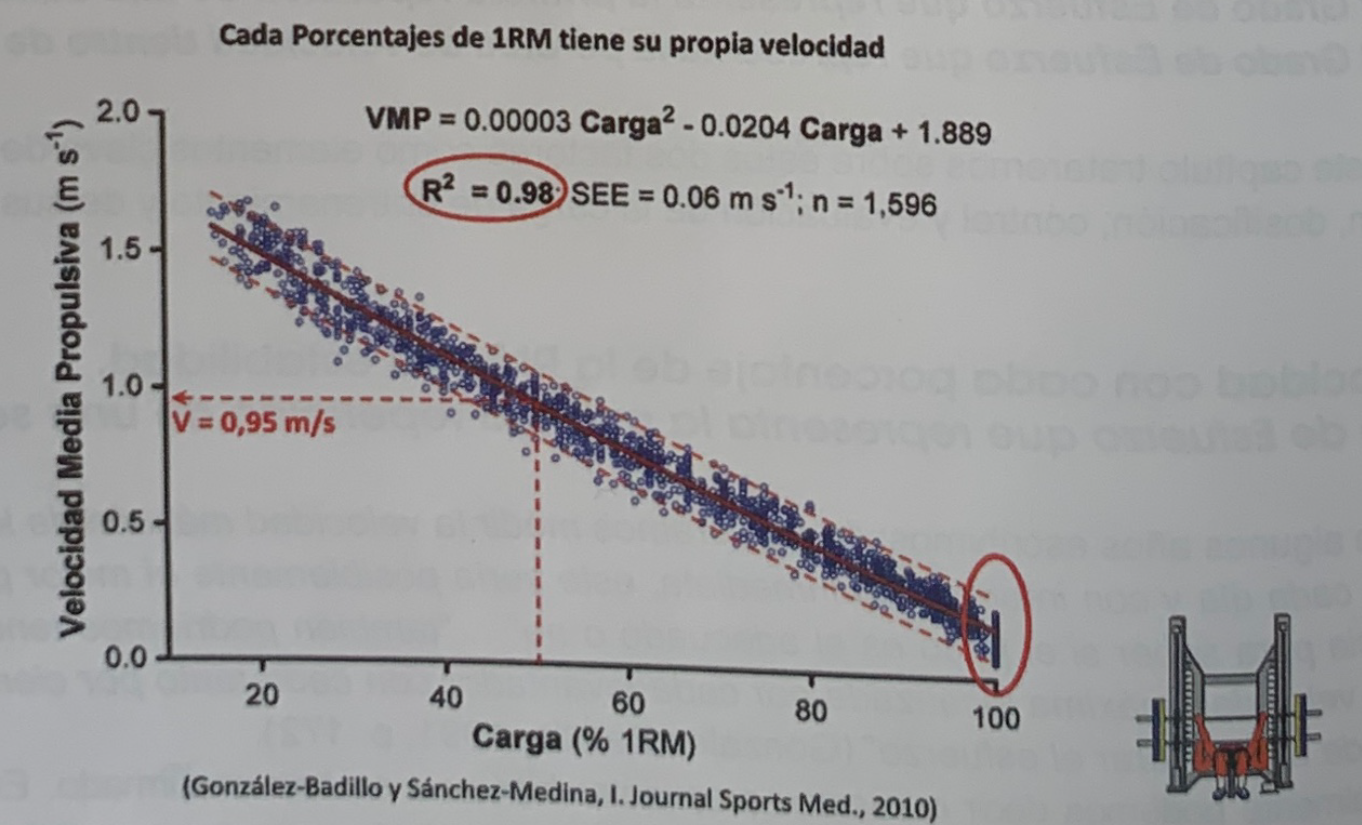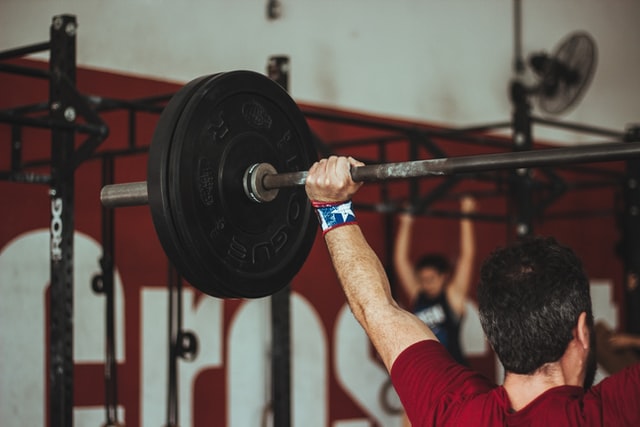Contributions of execution speed in training
The main contributions of execution speed in training are summarized below, and which have been explained in this other previous article. They are divided into four sections: the contributions of the speed of the first repetition, loss of speed in the series, percentage of repetitions performed with each loss of speed and the Effort Index.
In this series of articles we deal with some of the most important concepts of strength training, collecting notes from the recently published book Strength, Speed and Physical and Sports Performance written by renowned researchers Juan José González Badillo and Juan Ribas Serna.
SUMMARY
- Assess a subject’s strength and accurately determine their true percentage of 1RM without ever needing to perform a 1RM test or XRM test
- Program, dose and control training with high precision.
- Use strength training with all subjects regardless of their age and physical condition.
- Know the degree of individual adaptation pre-post training (in all cases) and the evolution of individual adaptation over time.
- The loss of speed in the series, together with the speed of the first repetition allow estimating training fatigue.
- The effort index is an independent variable that allows you to compare any training.
Contributions derived from the knowledge of the average velocity (average propulsive velocity, preferably) of the first repetition of the first series of an exercise
- Evaluate the strength of a subject without the need to perform a 1RM test or an XRM test at any time.
- Determine with high pressure what actual percentage of 1RM the subject is using as soon as he performs the first repetition at maximum speed with a given absolute load:
- Therefore, if the speed is measured every day, it can be determined with high precision if the absolute load proposed to the subject (kg) faithfully represents the true degree of programmed effort (% of real 1RM) as soon as the speed of the first repetition is measured. .
- Program, dose and control training with high precision through speed, and not through a theoretical percentage, not a real one, in most of the steps, of 1RM.
- Use strength training with all subjects, from children to the most advanced athletes or adults and older people who want to improve their health, without the need to do maximum effort tests (1RM, or XRM, for example) in any case. .

- Estimate the change in performance each day without the need to perform any tests, simply by measuring the speed with which an absolute load moves. If, for example, the difference in speed between 70 and 75% of the RM of a specific exercise were 0.08 m s-1, when the subject increases speed by 0.08 m s-1 Given the same absolute load, the load with which he trains will represent 5% less than the RM of the subject at that moment, so this will have increased in value. Naturally, if what occurs is a loss of speed at the same absolute load, we can be fairly sure that the subject is below its previous performance, and to a degree proportional to the loss of speed.
- If the speed of the first repetition is measured daily, weekly or simply before and after the training period or cycle, you can:
- Know the degree of individual adaptation pre-post training (in all cases) and the evolution of individual adaptation over time (if speed is measured daily OR weekly).
- Discover the degree of disparity in the adaptive responses of each subject.
- Check the effect of improving strength on other types of performance or exercises, trained or not.
- Assess the strength of athletes with minimal effort.
- Check what real relative intensities have caused the training effect: something completely unknown until now in the history of training.
- Verify that, in many cases, it may be enough to maintain an adequate progression of the absolute load, even though the relative intensity is stable or even tends to decrease throughout the training cycle.
- Show that it makes no sense to talk about “periodized training or not” (assuming the term should ever be used, which we don’t think is necessary), as it “ideal” is that training “does not have to be periodized”, well keep the same relative intensity (according to the usual termology, “non-periodized training”) and even if the relative intensity tends to decrease (which could shock some and be described as “detraining”), as the absolute intensity increases of training is clear proof that the effect of training is very positive. In addition, a wide range of upper relative intensities is kept available and useful which might need to be applied at later stages.
- Knowing what the minimum and maximum relative intensity at which each athlete trained really was and, therefore, not only knowing what the average effect was on the group, but also the individual effect of training and the load that caused it in each subject.
- Know specific data on the possible magnitude of the differences in the training load that can occur between subjects, with the same characteristics, that, theoretically, they had to do the same training, having verified that there can be differences in relative intensity between subjects of up to 20% at the end of the training cycle which, supposedly, was the “same” for all.
- Know the characteristics of the subjects as responders to training: differences in adaptation or response to training stimuli.
- Be aware of the need to consider the importance of training individualization: by nature, it is not possible to train a group of subjects with “the same training.”
- Realize that it is not possible to affirm that a certain training is “the best”. So we could say that “there are no trainings, but subjects who are trained or trainable subjects.”
- Discover new approaches to reflect on the relationship between the burden and its effect in general terms and on each person individually.
- Improve the training methodology, based on the contributions indicated in the previous points.
- Measure the speed with which RM is achieved. This is the only way to be able to consider an RM as “true” or “false”:
- Two MR values of the same subject cannot be compared if the values of the speeds with which they have been measured are not the same or very similar.
- If the speeds at which the pre-post training RMs have been measured are different, with differences ≥0.03 m s-1, these RMs are not equivalent, so comparing the values of the RMs (weights lifted) pre-post training would lead to wrong decisions, considering that there have been some changes of force (in the MRI) that are not real. In addition, the speeds with each percentage would appear to be different after training, without meaning that they really are.

- It allows to apply the best procedure for the assessment of the training effect, such as re-measuring the speed reached before the same absolute loads that were measured in the initial test:
- This procedure is the most consistent, since allows us to check if the objective of all strength training is met: to improve speed at the same absolute load, and, in addition, to it is the most accurate, since the effect of strength training is measured by the change in velocity under the same absolute load.
- Adjust the Load (intensity) to the actual physical situation of the subject in each training session.
- Guarantee the control of a determining variable of the load and the performance, such as the relative intensity. If not controlled, this variable would become a powerful foreign variable, which would undoubtedly influence performance, so its control is necessary, which had never been possible to date.. We do not know of (probably does not exist) any more precise procedure to control / match the relative intensity than the speed of execution with the first repetition of the series.
- Even the control of the loss of speed in the series, which we discuss below, no tendría sentido si no se tiene información precisa de la intensidad relativa de cada sesión, porque las pérdidas de velocidad serían ante intensidades relativas diferentes, con lo cual the loss of speed would lose all its power to control the load.
- Know the real average relative intensity of the maximum intensities applied during a training period. Which can be expressed as average speed or, more intuitively, simply expressing the average speed as a percentage of the RM, since we know the percentage that a certain speed represents. For example, if the average speed has been 1 ms-1 in the squat, the real relative intensity of the entire training cycle expressed in percentages of the RM would be 60% of the RM, and if the speed was 0.75-76 m·s-1 would correspond to 75% of the MR.
- Know the actual average relative intensity of all applied intensities, not just the maximum ones, during a training period.
- Check the effects of training at different speeds (light, medium and high loads), as well as at the average speed of all common loads moved pre-post training. This type of measurement allows more information about the effect of training and minimizes the possible error in the quantification of its effects. For this reason, it is a measurement that clearly exceeds what the usual MRI measurement offers to assess the effect of training.
Contributions derived from the knowledge of the loss of speed in the series
- Fatigue depends on the speed of the first repetition in the set and the percentage loss of speed in the set.
- The training load can be quantified by the loss of jumping ability (actually, loss of speed) and the loss of speed at a given absolute load in each session.
- It allows checking the relationship between the loss of jump and the loss of speed at a given load (load of m·s-1 in our case) per session and the effect of training.
- The loss of velocity pre-post training session with the load of 1 m s-1 and the loss of CMJ are accurate estimators of the metabolic stress caused by the training session..
- At loads of approximately 70-90% RM, ammonium increases exponentially from a loss of velocity of ~40% in the bench press and ~30% in the squat. In the case of the vertical jump, the increase in ammonia occurs when a pre-post effort jump loss of ~12% is reached. The same can be expressed by saying that it is necessary to do 1-2 repetitions more than half of the possible in the series in any of the two exercises so that the ammonia exceeds the resting values.

- Depending on the metabolic stress generated, a subject should not lose more than 20-35% (depending on exercises) of the speed of the first repetition in the series:
- Performance is probably not better if you lose a higher percentage of speed. In the squat exercise, an average speed loss in the set of 10-20% provided better results than a loss of 30-45%. In the bench press, a loss of 25-40% was better than 50-55%.
- People who train for health probably shouldn’t do even half of the possible reps in the set. For example, they shouldn’t lose even 20% speed on the full squat set or 25-30% on the bench press.
- For most experienced athletes with medium-high strength needs, it will probably be enough to perform at most half or 1-2 repetitions more than half of the possible ones. Although it is also estimated that athletes with lower strength needs probably, even if they are very experienced, do not need to perform even half of the possible repetitions in the series at any time (no more than 20% loss of speed in the series in the full squat or 25-30% in the bench press).
- Know the real average speed with which you have trained throughout the cycle individually and as a group.
- Know the real time under tension of the entire training.
- It is possible to know exactly the average speed lost in the series by different groups and by each participant:
- If it is taken into account that what is always programmed is an EC / degree of effort, knowledge of this data is the most relevant of what can be expected in relation to the load applied or generated by the training already carried out.
- Therefore, these indicators of fatigue are the ones that can get us closest to finding the relationship between the training performed and the effect produced:
- It allows us to reflect on the fact that with the same relative load, a difference of a few hundredths of more-1 (0,08-0,1 m·s -1Therefore, these indicators of fatigue are the ones that can get us closest to finding the relationship between the training performed and the effect produced: and in some cases obtaining statistically significant differences in their favor.
- Together with the knowledge of the speed of the first repetition in the series, it solves the problem of distributing the repetitions performed by RM percentage zones when trying to quantify the training load. since this procedure encompasses all the drawbacks associated with the use of MRI as a reference to dose and assess the training load:
- The solution to this problem lies in the use of speed zones instead of percentage zones, because the speed at which the charges have moved expresses very precisely what real relative intensity the subject has used.
- This type of distribution makes it possible to analyze discrepancies in the training effect when the same repetitions have been programmed for all subjects at the same relative intensity.
- If you don’t do it like that, following the traditional procedure of programming the same repetitions per set for all subjects, the least fatigued (those who can do more repetitions per set at the same relative intensity) they will present a greater number of repetitions at a higher speed, and, therefore, a higher average speed, which would not be reflected if the repetitions were distributed by percentages and not by speed zones.
- It allows to locate all the repetitions in their true zone, which is not possible if the percentage of the RM is taken as a reference.
- We understand that this type of information is the most relevant and precise to be able to carry out an analysis of the true load that has caused a certain effect., because it reflects very clearly the degree of effort made: number of repetitions with each relative intensity (in zones of one tenth of m·s-1 difference).
- If we add to the above the information provided on the loss of speed, the average speed and the average maximum speed of the entire training cycle, we will probably have the series of variables that allow a better analysis of the applied load.
- Talking about the average speed lost during the entire training cycle, knowing the speed of the first repetition of each maximum training load, is like talking about the degree of fatigue generated for each group and each subject individually. If we take into account that what is always programmed is a CE / degree of effort, which represents a degree of fatigue, which, in turn, validates the CE itself, the knowledge of this data is the most relevant of what can be expected in relation to the knowledge of the load applied or generated by the training already carried out.
Contributions derived from the knowledge of the percentage of repetitions performed before each percentage of speed loss in the series
- Given the same loss of speed in the series, the relationship between the repetitions that are done and those that can be done in the series is the same or very similar in all subjects. This allows us to affirm the following:
- When a certain percentage of the speed of execution in the series is lost, the same percentage of the possible repetitions in the series has been performed for each subject at intensities between 50 and 70% of the RM in the bench press.
- If the intensities are 75, 80 and 85%, given the same percentage of repetitions performed, the necessary speed losses will be 2.5, 5 and 10% less, respectively, than the losses corresponding to the intensities of 50 to 70%.
- If it is the squat exercise, given the same percentage of speed loss in the series, from 50 to 65% the percentage of repetitions performed is the same, and increases from 70% of the RM.
- It seems that the increase in the percentage of repetitions performed for the same loss of speed in the series occurs when the number of repetitions possible in the series is approximately 10.
- Being able to do the same number of repetitions in a series before a determined absolute load (individual loads for each subject) does not mean that you are training with the same percentage of the RM. For this reason, performing the same number of repetitions at the same relative load means that most athletes make a different effort than others. This is because the number of repetitions performed by each subject at the same relative intensity may be sufficiently different.
- If we take the loss of speed in the series at the same relative intensity as a reference, the efforts made will be very similar, although the number of repetitions made in each series is different for each subject.

- If a non-maximum number of repetitions is performed in the series, but common to all the subjects, each one will have done a different percentage of the total number of possible repetitions in the series:
- This means that having trained with the same relative intensity and the same number of repetitions in the series, the degree of fatigue, degree of effort or character of the effort could have been different in each case.
- It is the loss of velocity in the set that equalizes the effort, not the number of repetitions performed in the set at the same relative intensity.
- Therefore, the loss of speed in the series equals the efforts, the degree of fatigue generated, even if two people have done a different number of repetitions before the same relative load:
- This means that what would best express the degree of effort, and what should be programmed, is the speed of the first repetition and the loss of speed in the series, not the number of repetitions to perform in the series under a load (relative to or absolute).
- If the speed can be measured, the repetitions in the series should never be programmed, but the loss of speed in the series.
Applications derived from the knowledge of the Effort Index (IE) as an indicator of the Character of Effort
Remember that de Effort Index (IE) is the result of multiplying the speed of the first repetition (best repetition, which should be the first repetition in almost all cases) in the series by the percentage loss of speed in the series. Therefore, it is conditioned by the two key variables: the speed of the first repetition and the loss of speed in the series:
- The high validity shown by the expression of the CE through the IE as an indicator of fatigue or degree of effort, allows to advance the knowledge of the load (effort) that is programmed and, especially, of the load that has been generated in each subject once the training has been carried out.
- if we wanted compare the effect of different intensity ranges about the changes in force, or in other types of performance, it would be necessary to ensure that the IE was equivalent, and for this it would be necessary for the speed losses in the series or session to be different for each relative intensity, so that the efforts were equalized. Only if this is done in this way, it could be accepted that the independent variable of the study is truly the relative intensity.
- Therefore, it is not pertinent to affirm that training with a relative intensity is better or worse than with another, if the IE that has been generated with the different intensities has not been controlled.
- The CE expressed through the IE can have at least the following applications:
- Act as an independent variable of any study on the effect of training.
- It is necessary and decisive as a control variable.
- It is very useful for a better analysis of the effects of any design, because it allows checking the relationship between the IE (degree of fatigue) and the effects produced.
- The choice of the speed of the first repetition and the choice of the loss of speed in the series or session can be done and in some cases should be done depending on the IE or degree of effort that we want to program.









